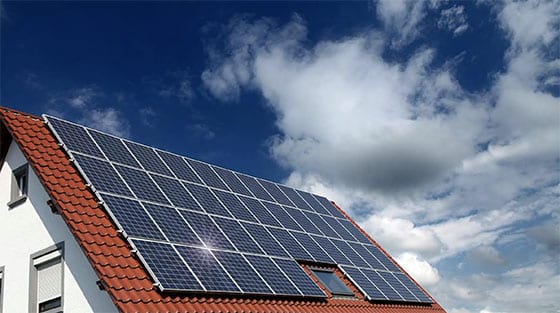The IRS is still offering incentives for switching to solar. Here’s how much you could save on your taxes and electricity bill.
By Tobie Stanger

Solar panels on a red-tile roof
Read the entire article here: https://www.consumerreports.org/solar-panels/how-to-get-a-solar-tax-credit
Solar-panel companies are aggressively marketing their products this season.
In my own neighborhood in a New York City suburb, door-to-door salespeople have been making the rounds. Reps from two different solar companies have stopped by, and that’s in addition to multiple mailings I’ve received.
Their pitch: Hurry if I want a big federal tax credit for a new solar-panel system, because it’ll be gone at year-end.
“Residential solar installers are notorious for using deadlines like this to create a sense of urgency with customers, and that’s definitely been the case this year,” says Michelle Davis, a solar-industry analyst with the market research company Wood Mackenzie.
Start Now
If you’ve heard the same hard sell, don’t believe it. The federal credit is still available next year, both for existing homes and new construction. It’s just slightly smaller: 26 percent of purchase and installation costs vs. 30 percent for 2019. For 2021, the credit will be worth 22 percent.
After that, it really does expire for individuals. (Owners of a home-based business can still get a 10 percent business tax credit for systems installed in 2022 and after.)
Prices vary by region and manufacturer, though. For my 1,700-square-foot home, I was told I’d need 388 square feet of solar panels, and my total cost would be $31,840, or $23,562 after my tax break.
Why opt for solar energy? You’ll use less energy from your local utility, which can save you a chunk of money, and it’s better for the environment because it reduces demand for fossil fuels. In some cases you can sell the utility the excess energy that your system produces.
A study by Sense, a company that produces home-energy monitoring devices, reports that in states with the most solar homes, residents with solar save, on average, $1,075 annually. Utah residents generated electricity equal to 84 percent of their utility bills. Californians offset 75 percent of their bills.
Even in less sunny Northeastern states—Connecticut, Massachusetts, New Hampshire, New York, Pennsylvania, and Vermont—solar users offset at least two-thirds of their utility bills. The Sense report notes that because solar panels are actually more efficient at lower temperatures, cooler states such as these get a boost in solar production.
Here’s how to take advantage of the Renewable Energy tax break, as well as information on state solar tax credits, how to calculate the break-even point when your costs are offset by your savings, and advice on finding a reputable installer.
Getting the Federal Tax Credit
With the Renewable Energy credit, you simply subtract your credit amount from the total tax the IRS says you must pay. (There’s no limit on the price of the solar system installation you choose.)
It’s different from a tax deduction, which reduces the amount of income you pay taxes on. “A $100 credit is worth $100 regardless of your tax rate,” says Kevin Martin, principal tax research analyst at H&R Block in Kansas City, Mo.
If you can’t use all of the credit in one year, you can carry it over into later years, Martin says. If, say, your federal taxes are $6,000 for 2020 and you’re eligible for a $7,000 tax credit for installing a solar system at your house, you can claim the leftover $1,000 as a credit toward your 2021 taxes.
But not every type of solar installation or expense is eligible for the tax credit. Qualified solar systems that meet IRS guidelines and produce electricity and heat water are covered. (So are small wind energy systems, geothermal heat pumps, and fuel cells.)
What Qualifies for the Solar Tax Credit
The entire bill for a qualified system, minus the sales tax. That includes solar panels; labor costs for on-site preparation, assembly, and installation of the system; and piping or wiring to connect the system to your house.
– Installation of a solar system in a primary or second house.
– Systems purchased outright or with a loan.
– Solar roofing tiles, like those being sold by Tesla.
– Solar installed in a property that you live in for at least part of the year. That could cover, for instance, a second home that you rent out when you’re not there. The credit is prorated based on how much time you spend in the residence.
– For a multifamily home in which you live but also collect rent, you may be eligible for either the residential or business tax credit, depending on how much of the property is used for business. Check with a tax expert for details.
What Doesn’t Qualify for the Solar Tax Credit
– Solar installed in an income property in which you don’t maintain your own residence.
– A system that’s leased. In that case, the company that leases it to you gets the credit, though it can pass along all or part of the savings as a discount to you.
– A solar system that’s used to heat a swimming pool or hot tub. The IRS is vague, though, about whether you can prorate your credit—that is, claim a portion of the credit if only a portion of the energy is used to heat your home. Talk to a tax expert for advice.
Getting Your State’s Tax Credit
Many states also offer tax credits for solar; some will continue even after the federal credit expires. Arizona and Massachusetts, for instance, currently give state income tax credits worth up to $1,000 toward solar installations. New York offers a state tax credit of up to $5,000. Maryland’s is $1,000 per system, plus 30 percent of the cost to install a giant battery to store the energy that’s produced.
For details on your state’s programs, go to your state’s tax authority website, or to dsireusa.org, a catalog of all state energy incentives run by the North Carolina Clean Energy Technology Center.
What’s Your Break-Even Point?
Even with the potential energy savings, investing in a solar system is worthwhile financially only if you plan to stay in your home for a few years. You need to calculate your break-even point; your true savings start after that. And don’t expect the salesman at your door to do the break-even math for you. The one who came to my house never did.
A useful tool for determining your payoff from solar is Google’s Project Sunroof. When you plug in your address and your average monthly electric bill, Google Earth will find your home, analyze its potential to generate electricity based on its sun exposure, and estimate your savings over 20 years.
It expresses that savings based on three ways that residents obtain solar panels: an outright purchase, a lease, or a loan. It will also tell you the break-even point, which in my case was six years. Keep in mind that the average life span of a photovoltaic solar panel—the most common type—is 20 to 30 years, according to the Solar Energy Industries Association.
One financial aspect that Google doesn’t include—and that can be difficult to figure out—is how solar could add to the value of your home.
A study in April by the real estate company Zillow found that solar systems add, on average, 4.1 percent to a home’s sales price. (The company says it derived that figure by looking at comparable homes with and without solar-energy systems that were listed for sale and sold on its site from March 1, 2018, to Feb. 28, 2019.)
Solar Shopping Tips
Ready to take the leap and go solar? Follow this advice from the Federal Trade Commission for finding a reputable company and for ways to pay for the system.
Vet the solar companies you’re considering. Search contractors’ names in the database of your local Better Business Bureau for complaints from other consumers. Get proof of required licenses, certificates, or insurance from each company you talk to.
Compare bids from several companies. Ask for price estimates from each company for the solar system you need. Be sure to compare the following among the proposals you get: installation costs and monthly fees, the minimum power a system will produce, and any warranties and repairs included. A typical solar warranty guarantees the system will produce at least 85 percent of its projected output for 10 years. Equipment is typically covered for at least 10 years.
Be sure to ask each company who pays if you need to repair your roof in the event the solar installation causes roof damage. If your roof shingles and other components are still under warranty, ask your roofer or the roofing manufacturer how to maintain those warranties in light of a solar installation. (Without an assurance by the solar or roofing companies, you’ll probably have to foot any repair bills yourself.)
Consider all financing options. If you’re thinking of leasing your system, keep in mind that solar leases typically last 20 years. If you move sooner, you’ll have to either pay the balance before selling or arrange for a lease transfer. Ask any company you deal with about its policy for transferring the lease to a new owner, and confirm that the same information is in the contract.
If you live in California, Florida, or Missouri, you can also take advantage of the Property Assessed Clean Energy (PACE) programs for solar financing. The solar contractor provides the loan, and you pay it back through monthly assessments on your property tax bill.
Editor’s note: This article has been updated to indicate that H&R Block is based in Kansas City, Mo., and that the solar tax credit is available for both existing homes and new construction.
About Tobie Stanger
I cover the money side of home-related purchases and improvements: avoiding scams, making sense of warranties and insurance, finding the best financing, and getting the most value for your dollar. For CR, I’ve also written about digital payments, credit and debit, taxes, supermarkets, financial planners, airlines, retirement and estate planning, shopping for electronics and hearing aids—even how to throw a knockout wedding on a shoestring. I am never bored. Find me on Twitter: @TobieStanger
